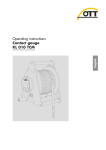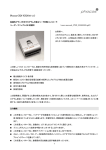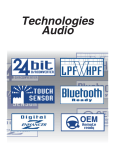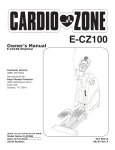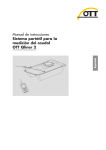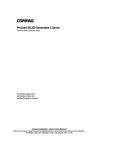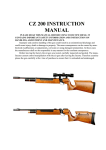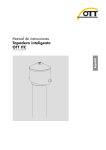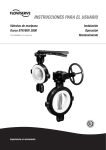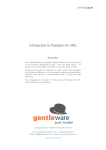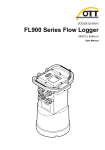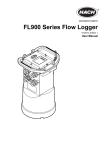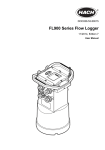Download Manual
Transcript
DOC026.97.80348 DOC026.97.80348 HL4 Sonde 11/2013, Edition 1 User Manual ENGLISH ONLY DOC026.97.80348 ENGLISH ONLY DOC026.97.80348 Table of contents Specifications on page 3 Maintenance on page 13 General information on page 3 Troubleshooting on page 17 Startup on page 6 Replacement parts and accessories on page 17 Operation on page 8 Specifications Specifications are subject to change without notice. Specification Details Dimensions Diameter: 4.44 cm (1.75 in.) without rubber bumpers; 5.33 cm (2.1 in.) with rubber bumpers Length: 51.43 cm (20.25 in.) with no internal battery pack and standard sensor guard; 66.358 cm (26.125 in.) with no internal battery pack and extended sensor guard; 62.23 cm (24.5 in.) with internal battery pack and standard sensor guard; 77.787 cm (30.625 in.) with internal battery pack and extended sensor guard Weight 2.2 kg (5 lb) with internal battery pack and storage/calibration cup Power requirements 6–24 VDC (12 VDC nominal) applied to the communications module, 12 VDC: 250 mW average, 18 W peak Internal battery pack (optional) Internal alkaline D-cell battery, non-rechargeable Operating temperature1 –5 to 50 °C (23 to 122 °F), non-freezing Storage temperature 1 to 50 °C (34 to 122 °F) Depth 200 m (656 ft) maximum Approximately 75 days of use with a 15-minute logging interval and a 30-second warm-up time with temperature, conductivity, pH and LDO sensors installed. Note: Some sensors cannot be used at 200 m (656 ft). Refer to the sensor documentation for the sensor depth specifications. Tensile strength (maximum) Mooring cap: 68 kg (150 lb); deployment cable: 227 kg (500 lb) Sensors Temperature sensor, four external sensor ports and optional internal depth sensor Refer to the sensor documentation for sensor specifications. Communications Communications module: USB, SDI-12, RS232 Modbus, RS485 Modbus and RS232 TTY Logging 4 GB of internal memory2; 1 second interval minimum 1 2 Operation outside of this temperature range can result in mechanical damage or faulty electronic performance. Sufficient memory to keep 5 years of continuous measurements with a 15-minute logging interval General information In no event will the manufacturer be liable for direct, indirect, special, incidental or consequential damages resulting from any defect or omission in this manual. The manufacturer reserves the right to make changes in this manual and the products it describes at any time, without notice or obligation. Revised editions are found on the manufacturer’s website. ENGLISH ONLY English 3 DOC026.97.80348 Safety information NOTICE The manufacturer is not responsible for any damages due to misapplication or misuse of this product including, without limitation, direct, incidental and consequential damages, and disclaims such damages to the full extent permitted under applicable law. The user is solely responsible to identify critical application risks and install appropriate mechanisms to protect processes during a possible equipment malfunction. Please read this entire manual before unpacking, setting up or operating this equipment. Pay attention to all danger and caution statements. Failure to do so could result in serious injury to the operator or damage to the equipment. Make sure that the protection provided by this equipment is not impaired. Do not use or install this equipment in any manner other than that specified in this manual. Use of hazard information DANGER Indicates a potentially or imminently hazardous situation which, if not avoided, will result in death or serious injury. WARNING Indicates a potentially or imminently hazardous situation which, if not avoided, could result in death or serious injury. CAUTION Indicates a potentially hazardous situation that may result in minor or moderate injury. NOTICE Indicates a situation which, if not avoided, may cause damage to the instrument. Information that requires special emphasis. Precautionary labels Read all labels and tags attached to the instrument. Personal injury or damage to the instrument could occur if not observed. A symbol on the instrument is referenced in the manual with a precautionary statement. This symbol, if noted on the instrument, references the instruction manual for operation and/or safety information. Electrical equipment marked with this symbol may not be disposed of in European public disposal systems after 12 August of 2005. In conformity with European local and national regulations (EU Directive 2002/96/EC), European electrical equipment users must now return old or end-of-life equipment to the Producer for disposal at no charge to the user. Note: For return for recycling, please contact the equipment producer or supplier for instructions on how to return endof-life equipment, producer-supplied electrical accessories, and all auxiliary items for proper disposal. Certification Canadian Radio Interference-Causing Equipment Regulation, IECS-003, Class A: Supporting test records reside with the manufacturer. This Class A digital apparatus meets all requirements of the Canadian Interference-Causing Equipment Regulations. Cet appareil numérique de classe A répond à toutes les exigences de la réglementation canadienne sur les équipements provoquant des interférences. FCC Part 15, Class "A" Limits Supporting test records reside with the manufacturer. The device complies with Part 15 of the FCC Rules. Operation is subject to the following conditions: 4 English ENGLISH ONLY DOC026.97.80348 1. The equipment may not cause harmful interference. 2. The equipment must accept any interference received, including interference that may cause undesired operation. Changes or modifications to this equipment not expressly approved by the party responsible for compliance could void the user's authority to operate the equipment. This equipment has been tested and found to comply with the limits for a Class A digital device, pursuant to Part 15 of the FCC rules. These limits are designed to provide reasonable protection against harmful interference when the equipment is operated in a commercial environment. This equipment generates, uses and can radiate radio frequency energy and, if not installed and used in accordance with the instruction manual, may cause harmful interference to radio communications. Operation of this equipment in a residential area is likely to cause harmful interference, in which case the user will be required to correct the interference at their expense. The following techniques can be used to reduce interference problems: 1. Disconnect the equipment from its power source to verify that it is or is not the source of the interference. 2. If the equipment is connected to the same outlet as the device experiencing interference, connect the equipment to a different outlet. 3. Move the equipment away from the device receiving the interference. 4. Reposition the receiving antenna for the device receiving the interference. 5. Try combinations of the above. Product overview NOTICE Do not use this instrument in water that contains contamination that will cause damage to the sensors or the housing (e.g., extreme acids or bases, high concentrations of organic solvents, oil/grease, toxic metals or radioactive waters). This portable instrument is used for spot measuring or unattended monitoring of environmental water sources (fresh and salt water). Refer to Figure 1. The parameters measured by the instrument are identified on the instrument and the Hydrolab Operating Software. This instrument has a temperature sensor, four external sensor ports and an optional internal depth sensor. The four external sensor ports can include a maximum of four different sensors. Refer to the part numbers on the sensors and the sensor documentation to identify the sensors installed. All sensors are installed at the factory and are not user-replaceable without authorization from the manufacturer. Figure 1 Instrument overview 1 Calibration cap for the storage/calibration cup 6 Middle rubber bumper (2x)3 2 Storage/Calibration cup1 7 Battery compartment4 3 Sensors in clear pH 4 buffer 8 End rubber bumper (2x)3 4 Locking screw (2x)2 9 Connector 5 Housing 1 2 3 4 The standard version is shown. For manufacturer use only Remove the middle bumpers and end bumpers as necessary to use the instrument in a narrow space such as a 5-cm (2-in.) well. Units with an internal battery pack only ENGLISH ONLY English 5 DOC026.97.80348 Product components Make sure that all components have been received. Refer to Figure 2. If any items are missing or damaged, contact the manufacturer or a sales representative immediately. Figure 2 Instrument components 1 AC power adapter 6 Silicone grease packet 2 Calibration cable1 7 Sensor maintenance kit(s)3 3 HL4 sonde 8 Hydrolab Operating Software CD 4 D-cell battery2 9 USB communications module 5 Mooring cap 10 Sensor guard with weight4 1 2 3 4 Not for use in water. Instrument damage will occur. Supplied with units with an internal battery pack Supplied with some sensors. The standard version is shown. Startup Install the battery WARNING Explosion hazard. Incorrect battery installation can cause the release of explosive gases. Be sure that the battery is of the approved chemical type and is inserted in the correct orientation. For instruments with an internal battery pack, install the supplied D-cell battery. Refer to Figure 3. 6 English ENGLISH ONLY DOC026.97.80348 Figure 3 Install the battery Install the software Install the Hydrolab Operating Software on a PC. Items to collect: • PC with Windows XP SP3 or newer • Hydrolab Operating Software CD 1. Put the CD in the PC. The installation program starts. 2. Complete the steps in the software prompts to install the software on the PC. Connect to the PC Connect the instrument to the PC. Items to collect: • • • • PC with Hydrolab Operating Software Calibration cable or optional deployment cable Communications module Power adapter* 1. Connect the instrument to the PC. Refer to Figure 4. To connect to a different power adapter or communications module than those shown, refer to the documentation supplied with the power adapter or the communications module. Note: An external power connection is optional for instruments with an internal battery pack. The battery is not used when external power is used. 2. At initial installation and each time a different USB port on the PC is used: a. Windows prompts that a new device is found and opens a wizard window. Select No, not this time to search for software, then click Next. b. Select Install the software automatically (Recommended), then click Next. No CD is necessary. Windows installs the software driver for the communications module. * Optional for instruments with an internal battery pack ENGLISH ONLY English 7 DOC026.97.80348 3. Start the Hydrolab Operating Software. The connected instrument shows in the Connect to Device field. Note: If step 2 is not done at initial installation, the instrument will not be shown in the Connect to Device field. 4. Select the instrument, then click Connect. Figure 4 Connect the instrument to the PC Operation Configuration Configure the software, instrument and sensor settings. Refer to Configuration in the online help. Calibration Calibrate the sensors before initial use, at regular intervals and after sensor maintenance or modifications. Refer to Calibration in the online help. Periodically, do a calibration check to make sure that measurements are still within tolerance range. Refer to Calibration in the online help. Prepare the sensors for calibration Before calibration, always rinse the storage/calibration cup and clean the sensors to prevent contamination of the calibration standards. 1. 2. 3. 4. Rinse the storage/calibration cup with clean water. Clean the sensors. Refer to the sensor documentation for instructions. Rinse the sensors at least three times with deionized water. Refer to Figure 5. Rinse the sensors at least two times with a calibration standard. Refer to Figure 5. For the best results, discard the deionized water and calibration standard after each rinse. 8 English ENGLISH ONLY DOC026.97.80348 Figure 5 Rinse the sensors Deployment guidelines NOTICE Always install the mooring cap or connect the deployment cable to the instrument before deployment to keep the connector dry. Do not use the calibration cable for deployment because the connector will get wet. NOTICE Always install the sensor guard before deployment or sensor damage can occur. • Do not apply more than 68 kg (150 lb) of additional weight to the instrument when the mooring cap is used. • Do not apply more than 113 kg (250 lb) of additional weight to the instrument when the deployment cable is used. • Do not hang weight from the sensor guard. Refer to Specifications on page 3 for the tensile strength of the mooring cap and deployment cable. Cable care • Lubricate the sealing surface of the mooring cap and the optional deployment cable with silicone grease on a cotton swab at regular intervals and as necessary. • Keep all non-waterproof cables (all cables except the deployment cable) in a clean, dry and noncorrosive environment. If a cable gets dirty or wet, clean and/or air dry the cable before use. • Do not put non-waterproof cables in a coil any tighter than 30.5 cm (12 in.) in diameter or cable damage can occur. • Do not put a knot in cables or use clips to mark a depth. • Do not bend or pull the deployment cable over pulleys with less than 10 cm (4 in.) radius or 20 cm (8 in.) in diameter. • Use a powered or hand-cranked reel with electrical slip-rings to lower and raise the instrument if the cables are very long. A lighter reel without slip-rings for shorter cables can be used. Short-term (attended) deployment NOTICE Do not put the instrument where the deployment cable could be cut or damaged by boat propellers or other moving objects. ENGLISH ONLY English 9 DOC026.97.80348 Deployment with a PC Items to collect: • • • • • PC with Hydrolab Operating Software Sensor guard Deployment cable USB communications module Power adapter** 1. Connect the instrument to the PC. Refer to Connect to the PC on page 7. Make sure to use the deployment cable and not the calibration cable. 2. Remove the storage/calibration cup and install the sensor guard. Keep the storage/calibration cup for later use. Refer to Figure 6. Do not let the sensors become dry. 3. Lower the instrument into the water to be measured. For the best results, make sure that all of the instrument is in the water. 4. Click Monitoring to view real-time measurements. Refer to Monitoring in the online help. When measurements are complete, prepare the instrument for travel. Refer to Prepare for storage or travel on page 16. Figure 6 Install the sensor guard Long-term (unattended) deployment Deployment with a mooring cap Only instruments with an internal battery pack can be deployed with a mooring cap. Items to collect: • • • • • • • PC with Hydrolab Operating Software Sensor guard Mooring cap Rope or wire line Calibration cable USB communications module Power adapter*** 1. In the office or the field, add a new log to the instrument. Measurements are saved to the new log according to the selected measurement interval and date range. a. Connect the instrument to a PC. Refer to Connect to the PC on page 7. ** *** Optional for instruments with an internal battery pack Optional for instruments with an internal battery pack 10 English ENGLISH ONLY DOC026.97.80348 b. Click Logging, then add a new log. Refer to Logging in the online help. c. Select File>Disconnect from Device to disconnect the instrument from the PC. Note: As an alternative, click Devices, select the instrument, then click Disconnect. d. Disconnect the calibration cable from the instrument. 2. Install the mooring cap on the instrument. Refer to Figure 7. Turn the bottom of the mooring cap to install it. Note: To remove the mooring cap, turn the bottom of the mooring cap. The top of the mooring cap will not turn when the mooring cap is installed. 3. In the field, attach a rope or wire line to the mooring cap. Refer to Figure 7. 4. Remove the storage/calibration cup and install the sensor guard. Refer to Figure 6 on page 10. Keep the storage/calibration cup for later use. Do not let the sensors become dry. 5. Lower the instrument into the water to be measured. For the best results, make sure that all of the instrument is in the water. 6. Attach the instrument to a buoy, anchor or structure. Refer to Attach to a buoy, anchor or structure on page 12. When deployment is complete, prepare the instrument for travel. Refer to Prepare for storage or travel on page 16. Figure 7 Install the mooring cap Deployment with a data acquisition system or controller To remotely collect real-time measurements from the instrument, connect the instrument to a data acquisition system (i.e., data logger or modem) or a controller with an applicable communications module. The instrument stays in low-power (sleep) mode until it receives a command from the external device to switch on, complete a measurement and transmit the measured parameters back to the external device. Refer to the online help for SDI-12 commands and TTY commands supported by the instrument. Refer to the manufacturer's website for Modbus commands. Configure the communications module Items to collect: • PC with Hydrolab Operating Software • Communications module 1. In the office or the field, connect the applicable communications module to a USB port on the PC. 2. Start the Hydrolab Operating Software. The connected communications module shows in the Connect to Device field. 3. Select the communications module, then click Connect. The configuration windows for the communications module shows. 4. Configure the communications module. Refer to Configuration in the online help. ENGLISH ONLY English 11 DOC026.97.80348 5. When configuration is completed, disconnect the communications cable from the PC. a. Select File>Disconnect from Device to disconnect the communications cable from the PC. Note: As an alternative, click Devices, select the communications cable, then click Disconnect. b. Disconnect the communications cable from the PC. Connect the communications module Items to collect: • Data acquisition system or controller • Communications module (configured) • External power source, 6-24 VDC (12 VDC nominal) **** 1. In the field, connect the communications module to the data acquisition system or controller. Refer to the documentation supplied with the communications module for wiring information. Refer to Data transmission and power wiring on page 12 for the wiring requirements for data transmission. 2. If the data acquisition system or controller cannot supply power to the communications module, connect an external power source to the communications module. Refer to Data transmission and power wiring on page 12 for the wiring requirements for external power. Data transmission and power wiring To connect data transmission lines to the communications module, make sure that the transmission cable is sufficient for the operating current and will transfer the data without distortion. For up to 305 m (1000 ft) of cable, three 26 AWG wires are sufficient. To connect external power to the communications module, make sure to use two 18 AWG wires for power. Smaller power wires can be used if the power supply is near the instrument. Instrument deployment Items to collect: • Deployment cable • Sensor guard 1. Connect the deployment cable to the communications module. Make sure to use the deployment cable and not the calibration cable. 2. Connect the deployment cable to the instrument. 3. Remove the storage/calibration cup and install the sensor guard. Keep the storage/calibration cup for later use. Refer to Figure 6 on page 10. Do not let the sensors become dry. 4. Lower the instrument into the water to be measured. For the best results, make sure that all of the instrument is in the water. Do not put the communications module in the water. 5. Attach the instrument and cabling to a structure. Refer to Attach to a buoy, anchor or structure on page 12. When deployment is complete, prepare the instrument for travel. Refer to Prepare for storage or travel on page 16. Attach to a buoy, anchor or structure NOTICE Do not use pipe clamps to attach the instrument because instrument damage can occur. For unattended monitoring, attach the instrument to a buoy, anchor or structure. **** Optional for instruments with an internal battery pack. Not used when the data acquisition system or the controller can supply power to the communications module. 12 English ENGLISH ONLY DOC026.97.80348 Install in a location: • Where instrument damage will not occur such as from floating material, sand, gravel, silt, navigation or vandalism • Where the instrument will not come in contact with mud such as after the water recedes • Where ice will not form around the instrument or sensors To attach the instrument to a: • Buoy—use a marking buoy that will not attract vandalism. • Structure—attach the instrument to the downstream side of a piling to prevent damage from floating material. Refer to Figure 8. Carefully install straps such as web belts and large plastic Tiewraps on both ends of the instrument housing. Attach the deployment cable in the same way (if used) to prevent cable damage from floating material, navigation and vandalism. To prevent vandalism, install the instrument and cable so they are not easily seen. Figure 8 Attach the instrument to a structure Maintenance CAUTION Multiple hazards. Only qualified personnel must conduct the tasks described in this section of the document. CAUTION Personal injury hazard. Because of pressure buildup inside of the instrument, removable parts can disengage with force when removed. Loosen and remove the parts slowly. Point the parts away from people and wear the appropriate protective equipment during maintenance or service activities. NOTICE Do not disassemble the instrument for maintenance without authorization from the manufacturer. If the internal components must be cleaned or repaired, contact the manufacturer. ENGLISH ONLY English 13 DOC026.97.80348 NOTICE Keep the instrument in a location where the sensors will not freeze or sensor damage will occur. Clean the housing and the sensor guard NOTICE To prevent damage to some sensors and the instrument, do not use solvents that dissolve plastic to clean the housing and sensor guard. At regular intervals, examine the instrument housing and sensor guard. Clean the housing and sensor guard as necessary to remove unwanted material and deposits. 1. Remove the sensor guard from the instrument. 2. Pour a minimum of 2.5 cm (1 in.) of pH 4 buffer or clean tap water into the storage/calibration cup. 3. Install the storage/calibration cup on the instrument. 4. Clean the housing and sensor guard with: • Mild detergent • Non-toxic, degreasing solution, such as Simple Green® (A registered trademark of Sunshine Makers, Inc.) • Warm water • Clean, soft toothbrush • Soft cloth and/or cotton swabs If necessary, soak the sensor guard and/or housing in water for at least 30 minutes to make the contaminates soft and easier to remove. 5. Rinse the housing and sensor guard with clean water. Clean the sensors At regular intervals, examine the sensors for unwanted material, deposits (inorganic and biological) and damage. Clean the sensors if unwanted material is found. In addition, clean the sensors if sensor performance has degraded. Refer to the sensor documentation for cleaning instructions. Replace any damaged parts (e.g., sensor membranes). Replace any parts with fouling (sedimentary and/or biological) that affects performance and cannot be removed. Refer to the sensor documentation for maintenance instructions. Replace the battery WARNING Explosion hazard. Incorrect battery installation can cause the release of explosive gases. Be sure that the battery is of the approved chemical type and is inserted in the correct orientation. WARNING Explosion hazard. An expired battery can cause hydrogen gas buildup inside the instrument. Replace the battery before it expires. Do not store the instrument for long periods with a battery installed. For instruments with an internal battery pack, replace the D-cell battery when the battery power level is low. Refer to Figure 3 on page 7. The battery power level is shown at the top of the Hydrolab Operating Software window. Replace the battery with the same type and rating. Refer to the internal battery pack requirements in Specifications on page 3. 14 English ENGLISH ONLY DOC026.97.80348 Keep the battery compartment dry when the battery is replaced. If water gets into the battery compartment, remove the battery, pour the water out and fully dry the compartment with a towel. Let the battery compartment air dry fully before use to prevent corrosion. Note: The internal clock battery is not user-replaceable without authorization from the manufacturer. Examine the O-rings and sealing gasket 1. At regular intervals, examine the O-rings and sealing gasket in the mooring cap for unwanted material, wear or damage. Refer to Figure 9 and Figure 10. 2. Remove any unwanted material from the O-rings and mooring cap. 3. Replace any O-rings with visible damage or wear (e.g., cracks or missing pieces). Replace with the O-rings from the manufacturer. 4. Apply silicone grease to the O-rings to prevent them from sticking and being pulled out of position. 5. Replace the mooring cap when damage or wear is visible on the sealing gasket. Figure 9 Sealing gasket location 1 Mooring cap sealing gasket ENGLISH ONLY English 15 DOC026.97.80348 Figure 10 O-ring locations 1 Battery compartment O-rings (4x) 3 Calibration cap O-ring 2 Storage/Calibration cup O-ring Prepare for storage or travel NOTICE Keep the instrument in a location where the water in the storage/calibration cup will not freeze or sensor damage will occur. NOTICE Do not keep the sensors in deionized water or sensor damage will occur. NOTICE Do not keep a turbidity sensor or flurometer in colored pH buffer or sensor damage will occur. NOTICE Do not keep the sensors in field sample water for long periods because biological growth can occur and contaminate the sensors. 1. Rinse the instrument and sensors with clean tap water. 2. Remove the sensor guard and install the storage/calibration cup. Pour a minimum of 2.5 cm (1 in.) of pH 4 buffer with no color or clean tap water into the storage/calibration cup. Refer to Figure 11. Note: It is not necessary for the sensors to be in the pH buffer or water. Note: Do not keep a total dissolved gas sensor wet or the sensor membrane will be damaged. 3. Make sure that the end bumper is installed on the storage/calibration cup. 4. Install the mooring cap on the connector to keep the connector clean and dry. 16 English ENGLISH ONLY DOC026.97.80348 5. Put all non-waterproof cables (all cables except the deployment cable) in a dry container. Do not put cables in a coil any tighter than 30.5 cm (12 in.) in diameter or cable damage can occur. 6. Before storage, clean the sensors. Refer to the sensor documentation. 7. For long-term storage, remove the internal D-cell battery if applicable. Refer to Figure 3 on page 7. No additional sensor preparation is necessary for long-term storage. Figure 11 Prepare for storage or travel Prepare for use after long-term storage After the instrument has been in storage for more than 1 month, 1. Replace the electrolyte in the sensors, if applicable. 2. Calibrate the sensors. Refer to Calibration on page 8. Rehydrate the sensors If the sensors become dry, soak them in water for 8 hours before use. Note: Do not keep a total dissolved gas sensor wet or the sensor membrane will be damaged. Troubleshooting Refer to Troubleshooting in the online help. Replacement parts and accessories WARNING Personal injury hazard. Use of non-approved parts may cause personal injury, damage to the instrument or equipment malfunction. The replacement parts in this section are approved by the manufacturer. Note: Product and Article numbers may vary for some selling regions. Contact the appropriate distributor or refer to the company website for contact information. ENGLISH ONLY English 17 DOC026.97.80348 Replacement parts Description Item no. Battery enclosure sleeve 9047300 Battery terminal cover 9032000 Bumper, rubber, end 9383100 Bumper, rubber, middle 9383200 Calibration cable 9310600 Cap, storage/calibration cup 9040900 Communications module, turck connector, dust cap 9046100 Communications module, USB 9162200 Communications module, USB, dust cap 9044400 Hydrolab Operating Software, CD 9282500 Maintenance kit, reference sensor 014660HY Maintenance kit, LDO sensor 007460 Maintenance kit, pH integrated sensor 013410HY Maintenance kit, turbidity sensor with wiper 9480800 Mooring cap 9310500 O-rings (4x), battery compartment 9048400 O-ring, storage/calibration cup and cap 002811 Power adapter, AC 002782 Power adapter, AC, dust cap 9044500 Sensor guard, standard 9383700 Sensor guard, standard with weight 9044100 Sensor guard, extended 9383800 Sensor guard, extended with weight 9044200 Sensor guard, weight 9041000 Shipping box, HL4 sonde 9309100 Storage/calibration cup, standard 003306 Storage/calibration cup, extended 003395HY Silicone grease packet 000298HY Accessories Description Item no. Communications module, SDI-12 9039600 Communications module, RS485 Modbus 9039700 Communications module, RS232 Modbus 9039800 Communications module, RS232 TTY 9312900 Dust cap, 9-pin connector, for communications modules 9039800 and 9312900 9044600 18 English ENGLISH ONLY DOC026.97.80348 Accessories (continued) Description Item no. Deployment cable, marine, 5 m CZ005 Deployment cable, marine, 10 m CZ010 Deployment cable, marine, 15 m CZ015 Deployment cable, marine, 25 m CZ025 Deployment cable, marine, 30 m CZ030 Deployment cable, marine, 50 m CZ050 Deployment cable, marine, 75 m CZ075 Deployment cable, marine, 100 m CZ100 Deployment cable, marine, 150 m CZ150 Deployment cable, marine, 200 m CZ200 Deployment cable, vented, 5 m CV005 Deployment cable, vented, 10 m CV010 ENGLISH ONLY English 19 DOC026.97.80348 20 English ENGLISH ONLY DOC026.97.80348 ENGLISH ONLY DOC026.97.80348 Hach Hydromet 5600 Lindbergh Drive Loveland, CO 80538 U.S.A. Tel. (970) 669-3050 (800) 949-3766 (U.S.A. only) Fax (970) 461-3921 [email protected] www.hachhydromet.com OTT Hydromet Ludwigstrasse 16 87437 Kempten, Germany Tel. +49 (0)8 31 5617-0 Fax +49 (0)8 31 5617-209 [email protected] www.ott.com © Hach Hydromet, 2013. All rights reserved. Printed in U.S.A. ENGLISH ONLY






















